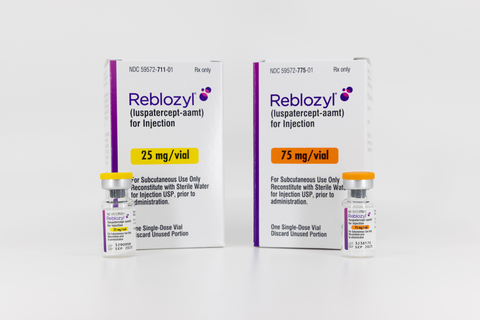Reblozyl is the first and only therapy to demonstrate superiority compared to an erythropoiesis stimulating agent (ESA) in MDS-related anemia based on interim results from pivotal Phase 3 COMMANDS trial, expanding approved population to ESA-naïve patients, regardless of ring sideroblast status
In head-to-head study, results showed Reblozyl nearly doubled the percent of patients achieving primary endpoint of concurrent transfusion independence and hemoglobin (Hb) increase vs. epoetin alfa, with a well-established safety profile
Bristol Myers Squibb (NYSE: BMY) today announced that the U.S. Food and Drug Administration (FDA) has approved Reblozyl® (luspatercept-aamt) for the treatment of anemia without previous erythropoiesis stimulating agent use (ESA-naïve) in adult patients with very low- to intermediate-risk myelodysplastic syndromes (MDS) who may require regular red blood cell (RBC) transfusions. This expanded indication to the first-line setting is based on interim results from the pivotal Phase 3 COMMANDS trial, in which Reblozyl demonstrated superior efficacy of concurrent RBC transfusion independence (RBC-TI) and hemoglobin (Hb) increase compared to epoetin alfa, an ESA, regardless of ring sideroblast status. These results underscore Reblozyl’s ability to address chronic anemia earlier in the treatment journey in a broader range of patients.
This press release features multimedia. View the full release here: https://www.businesswire.com/news/home/20230622657196/en/

Product image for download (Photo: Bristol Myers Squibb)
“For patients with lower-risk MDS, current standard therapies, including ESAs, have provided limited benefit in controlling anemia with only 1 in 3 patients responding for a duration of 6-18 months,” said Guillermo Garcia-Manero, M.D., lead investigator and Chief of the Section of Myelodysplastic Syndromes at The University of Texas MD Anderson Cancer Center. “Results from the COMMANDS study showed nearly twice as many patients treated with Reblozyl achieved transfusion independence of at least 12 weeks and concurrent hemoglobin increase compared to epoetin alfa. Today’s approval represents an important advancement for patients with lower-risk MDS.”
In the Phase 3 COMMANDS trial, results showed 58.5% (n=86) of patients treated with Reblozyl vs. 31.2% (n=48) of patients treated with epoetin alfa achieved the primary endpoint of RBC-TI of at least 12 weeks with a mean Hb increase of at least 1.5 g/dL within the first 24 weeks (p<0.0001). The most common (>10%) adverse reactions were diarrhea, fatigue, hypertension, peripheral edema, nausea, and dyspnea.
“Today's expanded approval of Reblozyl marks an important milestone in our commitment to MDS patients with anemia by providing a durable and more effective treatment option, with more convenient and less frequent administration,” said Wendy Short-Bartie, senior vice president and general manager, U.S. Hematology and Cell Therapy, Bristol Myers Squibb. “We remain dedicated to addressing hard-to-treat diseases with significant burden to patients and look forward to bringing this important option earlier in the treatment process.”
“The majority of patients with MDS experience chronic anemia and require RBC transfusions,” said Tracey Iraca, executive director, MDS Foundation. “The approval of Reblozyl in the first-line treatment of anemia for patients with lower-risk MDS represents a crucial step in making transfusion independence possible for more patients.”
Results from the COMMANDS study were featured in June as part of the press program at the American Society of Clinical Oncology (ASCO) Annual Meeting and plenary session at the European Hematology Association (EHA) Congress, with simultaneous publication in The Lancet. Reblozyl is being developed and commercialized through a global collaboration with Merck as of November 2021.
COMMANDS Study Results
COMMANDS (NCT03682536) is a Phase 3, open-label, randomized study evaluating the efficacy and safety of Reblozyl versus epoetin alfa for the treatment of anemia due to very low-, low- or intermediate-risk (IPSS-R) myelodysplastic syndrome (MDS) in patients who are red blood cell (RBC) transfusion dependent and were erythropoiesis stimulating agent (ESA)-naïve.
The primary endpoint evaluated in this study is RBC transfusion independence (RBC-TI) for 12 weeks with a mean hemoglobin (Hb) increase ≥1.5 g/dL. Key secondary endpoints include erythroid response (HI-E) of at least 8 weeks during weeks 1-24 of the study, RBC-TI ≥12 weeks and RBC-TI for 24 weeks. Eligible patients were ≥18 years old with lower-risk MDS who require transfusions. Patients were randomized 1:1 to receive subcutaneous Reblozyl (starting dose 1.0 mg/kg, titration up to 1.75 mg/kg) once every 3 weeks or epoetin alfa (starting dose 450 IU/kg, titration up to 1050 IU/kg) weekly for ≥24 weeks. The majority of study participants (>90%) were outside of the United States and a non-U.S.-licensed epoetin alfa product was used in the control arm for such patients.
At the time of the planned interim analysis (October 31, 2022), 147 evaluable patients received Reblozyl and 154 evaluable patients received epoetin alfa, with median treatment durations of 41.6 and 27 weeks, respectively. Results published in The Lancet showed:
- 58.5% (n=86) of patients receiving Reblozyl vs. 31.2% (n=48) of patients receiving epoetin alfa achieved the primary endpoint of RBC-TI of at least 12 weeks with concurrent mean Hb increase of at least 1.5 g/dL within the first 24 weeks (p<0.0001).
- HI-E increase of at least 8 weeks was achieved by 74.1% (n=109) of Reblozyl patients vs. 51.3% (n=79) of epoetin alfa patients (p<0.0001).
- Within the first 24 weeks of treatment, RBC-TI of at least 24 weeks was achieved by 47.6% (n=70) of Reblozyl patients vs. 29.2% (n=45) of epoetin alfa patients (p=0.0012).
- RBC-TI of at least 12 weeks was achieved by 66.7% (n=98) of Reblozyl patients vs. 46.1% (n=71) of epoetin alfa patients (p=0.0003).
Patients treated with Reblozyl demonstrated durable responses with nearly 2.5 years of median RBC-TI ≥12 weeks (126.6 weeks, week 1 to end of treatment). The most common (>10%) adverse reactions were diarrhea, fatigue, hypertension, peripheral edema, nausea, and dyspnea.
About MDS
Myelodysplastic syndromes (MDS) are a group of closely related blood cancers characterized by ineffective production of healthy red blood cells (RBC), white blood cells and platelets, which can lead to anemia and frequent or severe infections. People with MDS who develop anemia often require blood transfusions to increase the number of healthy RBCs in circulation. Frequent transfusions are associated with an increased risk of iron overload, transfusion reactions and infections. Patients who become RBC transfusion-dependent have a significantly shorter overall survival than those who are not dependent on transfusions, partially due to iron overload or to more severe bone marrow disease than in non-transfusion dependent patients.
About Reblozyl® (luspatercept-aamt)
Reblozyl, a first-in-class therapeutic option, promotes late-stage red blood cell maturation in animal models. Reblozyl is being developed and commercialized through a global collaboration and North American co-promotion with Merck following Merck’s acquisition of Acceleron Pharma, Inc. in November 2021. As part of the collaboration, Merck receives milestone and royalty payments. With this approval, Reblozyl is indicated in the U.S. for the treatment of:
- anemia in adult patients with beta thalassemia who require regular red blood cell (RBC) transfusions, and
- anemia without previous erythropoiesis stimulating agent use (ESA-naïve) in adult patients with very low- to intermediate-risk myelodysplastic syndromes (MDS) who may require regular red blood cell (RBC) transfusions.
- anemia failing an erythropoiesis stimulating agent and requiring 2 or more red blood cell (RBC) units over 8 weeks in adult patients with very low- to intermediate-risk myelodysplastic syndrome with ring sideroblasts (MDS-RS) or with myelodysplastic/myeloproliferative neoplasm with ring sideroblasts and thrombocytosis (MDS/MPN-RS-T).
Reblozyl is not indicated for use as a substitute for RBC transfusions in patients who require immediate correction of anemia. In the U.S., Reblozyl is not indicated for use in patients with non-transfusion-dependent beta thalassemia.
U.S. Important Safety Information
WARNINGS AND PRECAUTIONS
Thrombosis/Thromboembolism
In adult patients with beta thalassemia, thromboembolic events (TEE) were reported in 8/223 (3.6%) of REBLOZYL-treated patients. TEEs included deep vein thrombosis, pulmonary embolus, portal vein thrombosis, and ischemic stroke. Patients with known risk factors for thromboembolism (splenectomy or concomitant use of hormone replacement therapy) may be at further increased risk of thromboembolic conditions. Consider thromboprophylaxis in patients at increased risk of TEE. Monitor patients for signs and symptoms of thromboembolic events and institute treatment promptly.
Hypertension
Hypertension was reported in 11.4% (63/554) of REBLOZYL-treated patients. Across clinical studies, the incidence of Grade 3 to 4 hypertension ranged from 2% to 9.6%. In patients with beta thalassemia with normal baseline blood pressure, 13 (6.2%) patients developed systolic blood pressure (SBP) ≥130 mm Hg and 33 (16.6%) patients developed diastolic blood pressure (DBP) ≥80 mm Hg. In ESA-refractory or -intolerant adult patients with MDS with normal baseline blood pressure, 26 (30%) patients developed SBP ≥130 mm Hg and 23 (16%) patients developed DBP ≥80 mm Hg. In ESA-naïve adult patients with MDS with normal baseline blood pressure, 23 (36%) patients developed SBP ≥140 mm Hg and 11 (6%) patients developed DBP ≥80 mm Hg. Monitor blood pressure prior to each administration. Manage new or exacerbations of preexisting hypertension using anti-hypertensive agents.
Extramedullary Hematopoietic (EMH) Masses
In adult patients with transfusion-dependent beta thalassemia, EMH masses were observed in 3.2% of REBLOZYL-treated patients, with spinal cord compression symptoms due to EMH masses occurring in 1.9% of patients (BELIEVE and REBLOZYL long-term follow-up study).
In a study of adult patients with non-transfusion-dependent beta thalassemia, a higher incidence of EMH masses was observed in 6.3% of REBLOZYL-treated patients vs. 2% of placebo-treated patients in the double-blind phase of the study, with spinal cord compression due to EMH masses occurring in 1 patient with a prior history of EMH. REBLOZYL is not indicated for use in patients with non-transfusion-dependent beta thalassemia.
Possible risk factors for the development of EMH masses in patients with beta thalassemia include history of EMH masses, splenectomy, splenomegaly, hepatomegaly, or low baseline hemoglobin (<8.5 g/dL). Signs and symptoms may vary depending on the anatomical location. Monitor patients with beta thalassemia at initiation and during treatment for symptoms and signs or complications resulting from the EMH masses and treat according to clinical guidelines. Discontinue treatment with REBLOZYL in case of serious complications due to EMH masses. Avoid use of REBLOZYL in patients requiring treatment to control the growth of EMH masses.
Embryo-Fetal Toxicity
REBLOZYL may cause fetal harm when administered to a pregnant woman. REBLOZYL caused increased post-implantation loss, decreased litter size, and an increased incidence of skeletal variations in pregnant rat and rabbit studies. Advise pregnant women of the potential risk to a fetus. Advise females of reproductive potential to use effective contraception during treatment and for at least 3 months after the final dose.
ADVERSE REACTIONS
Beta-Thalassemia
Serious adverse reactions occurred in 3.6% of patients on REBLOZYL. Serious adverse reactions occurring in 1% of patients included cerebrovascular accident and deep vein thrombosis. A fatal adverse reaction occurred in 1 patient treated with REBLOZYL who died due to an unconfirmed case of acute myeloid leukemia (AML).
Most common adverse reactions (at least 10% for REBLOZYL and 1% more than placebo) were headache (26% vs 24%), bone pain (20% vs 8%), arthralgia (19% vs 12%), fatigue (14% vs 13%), cough (14% vs 11%), abdominal pain (14% vs 12%), diarrhea (12% vs 10%) and dizziness (11% vs 5%).
ESA-naïve adult patients with Myelodysplastic Syndromes
Grade ≥3 (≥2%) adverse reactions included hypertension and dyspnea.
The most common (≥10%) all-grade adverse reactions included diarrhea, fatigue, hypertension, peripheral edema, nausea, and dyspnea.
ESA-refractory or -intolerant adult patients with Myelodysplastic Syndromes
Grade ≥3 (≥2%) adverse reactions included fatigue, hypertension, syncope and musculoskeletal pain. A fatal adverse reaction occurred in 5 (2.1%) patients.
The most common (≥10%) adverse reactions included fatigue, musculoskeletal pain, dizziness, diarrhea, nausea, hypersensitivity reactions, hypertension, headache, upper respiratory tract infection, bronchitis, and urinary tract infection.
LACTATION
It is not known whether REBLOZYL is excreted into human milk or absorbed systemically after ingestion by a nursing infant. REBLOZYL was detected in milk of lactating rats. When a drug is present in animal milk, it is likely that the drug will be present in human milk. Because many drugs are excreted in human milk, and because of the unknown effects of REBLOZYL in infants, a decision should be made whether to discontinue nursing or to discontinue treatment. Because of the potential for serious adverse reactions in the breastfed child, breastfeeding is not recommended during treatment and for 3 months after the last dose.
DRUG ABUSE POTENTIAL
Abuse: Abuse of REBLOZYL may be seen in athletes for the effects on erythropoiesis. Misuse of drugs that increase erythropoiesis, such as REBLOZYL, by healthy persons may lead to polycythemia, which may be associated with life-threatening cardiovascular complications.
Please see accompanying U.S. Full Prescribing Information for REBLOZYL.
Bristol Myers Squibb: Creating a Better Future for People with Cancer
Bristol Myers Squibb is inspired by a single vision — transforming people’s lives through science. The goal of the company’s cancer research is to deliver medicines that offer each patient a better, healthier life and to make cure a possibility. Building on a legacy across a broad range of cancers that have changed survival expectations for many, Bristol Myers Squibb researchers are exploring new frontiers in personalized medicine, and through innovative digital platforms, are turning data into insights that sharpen their focus. Deep scientific expertise, cutting-edge capabilities and discovery platforms enable the company to look at cancer from every angle. Cancer can have a relentless grasp on many parts of a patient’s life, and Bristol Myers Squibb is committed to taking actions to address all aspects of care, from diagnosis to survivorship. Because as a leader in cancer care, Bristol Myers Squibb is working to empower all people with cancer to have a better future.
About Bristol Myers Squibb
Bristol Myers Squibb is a global biopharmaceutical company whose mission is to discover, develop and deliver innovative medicines that help patients prevail over serious diseases. For more information about Bristol Myers Squibb, visit us at BMS.com or follow us on LinkedIn, Twitter, YouTube, Facebook and Instagram.
Forward-Looking Statement of Bristol Myers Squibb
This press release contains “forward-looking statements” within the meaning of the Private Securities Litigation Reform Act of 1995 regarding, among other things, the research, development and commercialization of pharmaceutical products. All statements that are not statements of historical facts are, or may be deemed to be, forward-looking statements. Such forward-looking statements are based on current expectations and projections about our future financial results, goals, plans and objectives and involve inherent risks, assumptions and uncertainties, including internal or external factors that could delay, divert or change any of them in the next several years, that are difficult to predict, may be beyond our control and could cause our future financial results, goals, plans and objectives to differ materially from those expressed in, or implied by, the statements. These risks, assumptions, uncertainties and other factors include, among others, whether Reblozyl® (luspatercept-aamt) for the additional indication described in this release will be commercially successful, any marketing approvals, if granted, may have significant limitations on their use, and that continued approval of such product candidate for such additional indication described in this release may be contingent upon verification and description of clinical benefit in confirmatory trials. Forward-looking statements in this press release should be evaluated together with the many risks and uncertainties that affect Bristol Myers Squibb’s business and market, particularly those identified in the cautionary statement and risk factors discussion in Bristol Myers Squibb’s Annual Report on Form 10-K for the year ended December 31, 2022, as updated by our subsequent Quarterly Reports on Form 10-Q, Current Reports on Form 8-K and other filings with the Securities and Exchange Commission. The forward-looking statements included in this document are made only as of the date of this document and except as otherwise required by applicable law, Bristol Myers Squibb undertakes no obligation to publicly update or revise any forward-looking statement, whether as a result of new information, future events, changed circumstances or otherwise.
corporatefinancial-news
View source version on businesswire.com: https://www.businesswire.com/news/home/20230622657196/en/
$BMY announces the #FDA approval of its first-line #anemia treatment for adult patients with very low- to intermediate-risk myelodysplastic syndromes (#MDS).
Contacts
Bristol Myers Squibb
Media Inquiries: media@bms.com
Investors: investor.relations@bms.com






